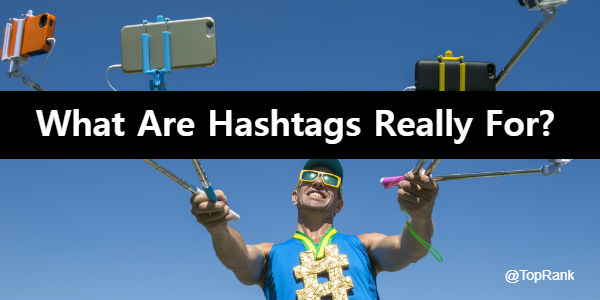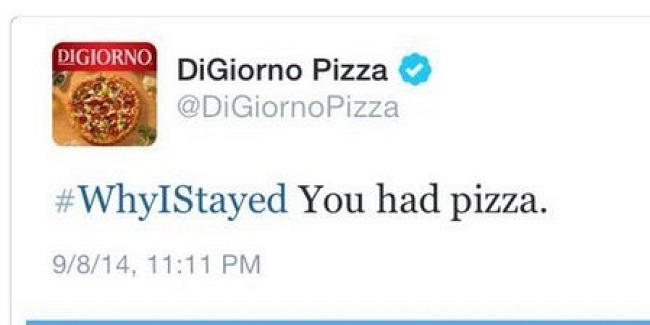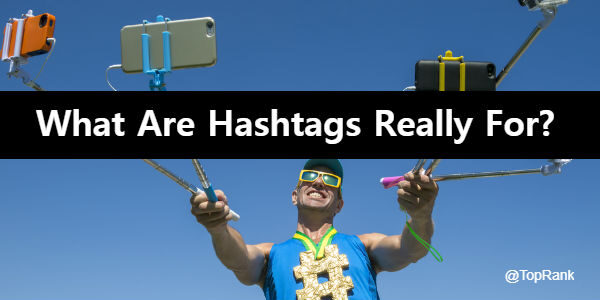
In late 2014, the hashtag #WhyIStayed was trending on Twitter. Frozen pizza slinger DiGiorno, known for being snarky and clever on social media, wanted to join the fun:

There was just one problem: #WhyIStayed started in response to a video of domestic abuse. Women used the hashtag to tell their own story of abuse and talk about the societal pressures that led them to stay with their abusers.
At best, DiGiorno looked clueless. At worst, it looked like they were making light of a very serious issue. All they wanted was a little brand visibility…and they got it, but not in the way they were hoping.
Hashtags are an integral part of Twitter and Instagram (and Facebook, to a much lesser extent). As such, they should be part of our social media marketing on each platform. But as DiGiorno and many other brands have shown, it’s not enough to look at the trending tags and hop on board. Marketers need to understand what hashtags are for and how our audience is using them before we jump in.
Here are the #fundamentals you need to avoid invisibility or embarrassment with hashtags.
#History
Hashtags started as a feature on IRC (Internet Relay Chat) channels back in 1988, when the internet still ran on steam turbine power. The “#” in front of channel meant that it was available for users across the internet, not just on a local area network.
Twenty years later, IRC fans who were early Twitter adopters proposed using the symbol to help classify common topics or groups. Twitter itself didn’t officially recognize hashtags for two more years. In 2009, the site started automatically hyperlinking hashtags to search results.
Facebook added hashtags in 2013, but they don’t see as much use on the platform. By contrast, Facebook-owned Instagram practically runs on hashtags. It’s not unusual to see a post with a four-word captioned followed by a paragraph of tags: #NoFilter #WokeUpLikeThis #BeachLife #SanDiego #ChihuahuaLove. Clicking any of the tags leads to a custom feed of images with the same tag, much like Twitter’s search functionality works.
#WhatHashtagsAreNot
Hashtags began as a way to categorize information for future searchers, much like the category or topic tags on a blog. In that case, using the right hashtags is more like SEO than anything else; it’s all about making sure your message comes up for the right query.
But hashtags aren’t really for search anymore. Hardly anyone is going to the search box on Twitter or Instagram and putting in a keyword to pull up a specific hashtag.
Hashtags are not really for marketers to boost their brand or their content, either. We can strategically use hashtags for that purpose, but we must remember that’s an off-label use. It’s important to tread lightly on using hashtags promotionally — as DiGiorno and many others can attest.
If it’s not about search or self-promotion, how should marketers think about hashtags? Or, better question, how does your audience think about hashtags?
Odds are, though, your audience doesn’t actively think about why they use or interact with a specific tag. There’s an innate understanding that makes some tags look “right” or “natural,” while others feel “forced” or “commercial.”
The best way I can think of to express that innate understanding is:
#HashtagsAreAConversation
Social media feeds move fast. Hashtags are a way for users to block out space to have a conversation. “We’re telling this type of story in here.” “We’re sharing this type of picture in here.” Using a specific existing hashtag should come with the knowledge that you’re entering someone else’s conversation space.
The social media manager at DiGiorno likely wouldn’t go up to a group of people talking about a sad and serious topic in hushed tones and shout, “PIZZA!” But that’s exactly what they did on Twitter.
So before you jump into a conversation, make sure that:
- You understand what’s being discussed
- Your brand has (and should have) a position on the topic
- You have something relevant to contribute
When you’re making your own hashtags, keep in mind that you’re starting a conversation. You can’t control who contributes to that conversation and what they might add to it.
For example, in 2012 McDonald’s used the hashtag #McDStories in a tweet, seemingly inviting users to share their own special memories of the chain. Instead, they got stories about food poisoning, diabetes, heart attacks, and animal cruelty.
It turns out McDonald’s had intended to use the tag to promote stories from employees and others affiliated with the brand. But they accidentally started a much wider conversation. With a little forethought, the mess could have been avoided.
So, when creating your own hashtag, keep in mind:
- Who are you talking to?
- What are you trying to say?
- How else could your hashtag be interpreted?
- What other conversations might it start?
#GeneralHashtagTips
Good hashtaggery starts with understanding that hashtags are a conversation. From there, the optimum tactics for using hashtags vary from platform to platform. The good folks at Buffer have an in-depth guide that touches on each of the major social media sites.
Here are some simple tips that I recommend to supplement Buffer’s advice:
- Use hashtags sparingly on Twitter; no more than 2 per post, preferably just one
- Don’t use tags on paid tweets. They’re proven to dilute your CTA
- Go nuts on Instagram; 11 hashtags is the optimal number
- Don’t bother tagging on Facebook. Research shows your post will do better without them
- Use CamelCase to keep longer tags legible (Remember the “susanalbumparty” debacle?)
#HashWithCare
Hashtags started as a tagging tool for search. Today, they’re used to create a space for conversations, group people with similar interests, and fill Instagram feeds with puppies. To be most successful with your hashtags, respect conversations that exist already, and be cautious about the conversations you start.
Need to #LevelUp your social media marketing? TopRank Marketing can help.



